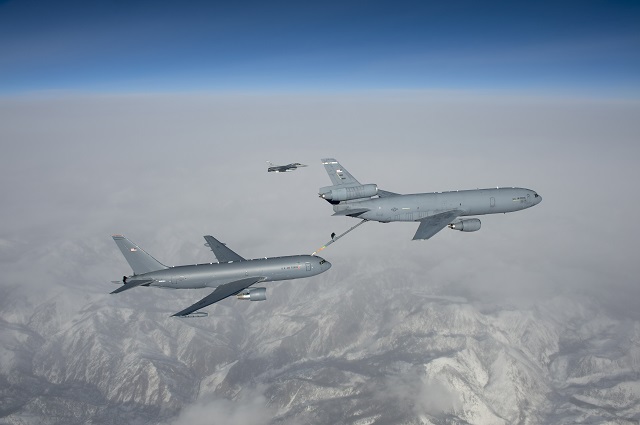The narrow window for Boeing to deliver 18 operational KC-46A Pegasus tankers to the US Air Force by August 2017 includes little to no room for error and a series of tests and events must go right to achieve that significant contractual milestone.
The $5 billion development programme is about eight months behind its original schedule after facing a number of setbacks, but company officials have committed to achieving the “required assets available” milestone, meaning 18 jets delivered to two air force bases between March and August next year.
But while USAF officials applaud that ambitions goal, they say in an interview with Flightglobal that schedule – not cost or technical difficulties – is the next-generation tanker project’s main challenge. Even if those tankers are in place by August, Air Mobility Command (AMC) won’t have had enough time with the 767-2C-based tankers to declare initial operational capability on time.

Boeing
USAF programme executive officer for tankers Gen Duke Richardson says Boeing had planned to begin delivering aircraft over 12 months starting this August but to account for delays in passing the milestone C review means 18 deliveries will be phased over six months.
“[AMC commander Gen Carlton Everhart] is not going to declare it until they’re ready to take the KC-46 to war,” says Richardson. “It’s going to take them a little while to ramp up. IOC is not a contractual requirement, it’s really a warfighter requirement.”
Only two aircraft currently flying in support of FAA type certification and aerial refuelling demonstration and the first KC-46A recently passed fuel to an F-16 and F/A-18 and then received fuel from a KC-10. The developmental tanker must now refuel an AV-8B, A-10 and C-17 to satisfy a “milestone C” decision review board that had planned to convene in April, but is now tracking toward early May.
Until then, the air force cannot award the first two low-rate production contracts for 7 and 12 aircraft to satisfy the required assets milestone. Boeing must also delivery enough spare parts and engines and correct any technical deficiencies revealed in ground and flight testing.
“Those must all happen by August of 2017, so there’s certainly a lot of pressure there,” says Richardson. “EMD-2 and EMD-4, by the way, are needed to get through the system verification review quickly. If we have four aircraft flying, we can burn through those reviews faster than with just two aircraft.”

Boeing
The programme’s favourable contract terms mean the air force is doing everything in its power to uphold its end of the bargain by programming enough funds across its latest five-year spending plan to purchase 15 aircraft per year, with annual lots expected to be awarded each January.
“Through the contract that was competed, we the government get rewarded for stability,” says Richardson. “Our best price point is actually 15 aircraft per year. Our plan is to awarded Lot 3 in January of next year.”
Col John Newberry, who took over as the air force KC-46A programme manager on 8 February, says his team is “laser-focused” on achieving milestone C and graduating from development to production. “I’m confident the programme is on the right track and we’re pressing to milestone C,” he says.
Richardson says schedule issues aside, the KC-46A programme is healthy and Boeing is transparent and hasn’t “cut corners”. “That stuff looks easy, but it’s the culmination of five years-worth of effort,” he says. “It’s pretty darn challenging to have a controlled mid-air collision in flight.”
The air force will buy 94 KC-46s through fiscal year 2021 with 81 of the remaining 175-aircraft order to be furnished through the 2020s. The service will buy 42 wing-mounted aerial refuelling pod sets.

Boeing
Source: FlightGlobal.com



















